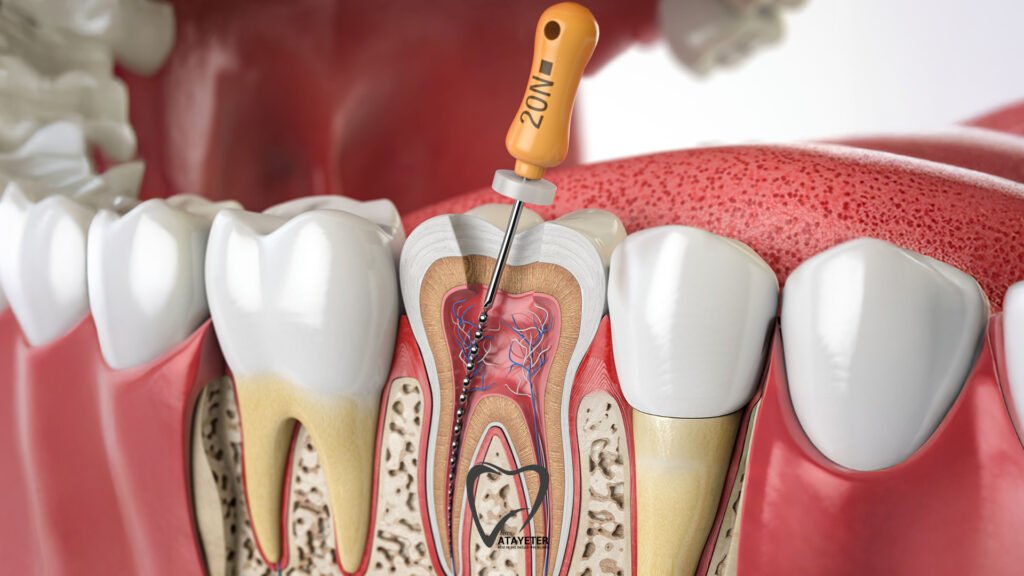Dental health is a vital issue that directly impacts not only the oral cavity but also our entire body. Healthy teeth are essential for chewing comfortably, eating healthily, smiling with confidence, and expressing ourselves better in our social lives. Unfortunately, however, teeth can become damaged over time for various reasons. Cavities, trauma, deep fillings, gum problems, or even minor, neglected issues can progress to the inner tissue of the tooth. At this point, the first solution that comes to mind for most people is tooth extraction.However, thanks to the advanced methods offered by modern dentistry, this is no longer inevitable. Root canal treatment allows us to save the damaged tooth without extraction and continue to use it for years. This preserves the natural tooth structure and achieves an aesthetically and functionally healthy oral structure.
What is Root Canal Treatment
It is one of the most commonly performed and tooth-saving procedures in dentistry. Simply put: The vital central area within the tooth, containing nerves and blood vessels, is called the “pulp.” The pulp nourishes the tooth and keeps it alive. However, deep decay, trauma to the tooth, repeated dental procedures, or gum problems can damage the pulp. In this case, the tooth becomes unable to defend itself, becomes inflamed, and often experiences severe pain.
This is where root canal treatment becomes a life-saving treatment. During treatment, the inflamed or damaged pulp tissue is carefully cleaned. Then, the root canals are shaped and disinfected using specialized instruments. During this entire process, the tooth is thoroughly disinfected and filled with biocompatible filling materials to prevent recurrence of infection. This eliminates pain and allows the tooth to remain healthy in the mouth for many years without extraction.

One of the biggest advantages is preserving the natural tooth. Because no artificial denture or implant can replace your own tooth. Thanks to modern techniques and advanced equipment, root canal treatment can now be performed quickly, comfortably, and painlessly. In short, root canal treatment is an extremely valuable treatment method that eliminates the risk of tooth loss and restores a healthy smile.
When Should a Root Canal Be Performed
Determining when a root canal is necessary is actually easier than you might think, because our teeth never fail to give us signals. Most patients usually notice it when they experience severe pain. But the interesting thing is, you don’t always have to experience excruciating pain; sometimes even seemingly minor symptoms can signal a serious problem with the tooth’s internal structure.
For example, deep decay that has reached the nerve of the tooth is one of the most common causes. Additionally, prolonged sensitivity to hot and cold, especially pain that persists for minutes after eating, indicates a problem with the pulp, or the nerve tissue of the tooth. Pain that wakes you up at night or throbbing pain when chewing also strongly indicates the need for root canal treatment. Darkening of the tooth’s color over time is another important sign that the inner tissue has lost its vitality.
Sometimes, swelling or abscess formation on the gums may also indicate root canal treatment. Bubble-like swellings may appear on the gums when the infection begins to spread from the root outward. Trauma should also be considered; For example, when a tooth fractures or cracks as a result of an impact, the pulp may be exposed, making root canal treatment essential to save the tooth.

How is Root Canal Treatment Performed
It’s a meticulous procedure that can often be completed in a single visit, but depending on the severity of the infection and the structure of the tooth, it can be spread over several sessions. The process proceeds step-by-step, prioritizing the patient’s comfort.
First, the examination and diagnosis phase begins. The dentist takes the necessary X-rays and thoroughly examines the tooth’s root structure and the extent of the decay or infection. Local anesthesia is then administered, so the patient feels no pain or discomfort during the procedure.
Next, a small incision is made in the upper part of the tooth to access the pulp chamber. Any inflamed or damaged nerves and blood vessels are carefully cleaned. This stage is one of the most critical points in restoring the tooth’s health. After the cleaning process, the root canals are shaped with special instruments and thoroughly disinfected. This minimizes the possibility of bacteria remaining inside the tooth.
Once the canals are completely prepared, they are filled with biocompatible filling materials and sealed. This is crucial to prevent future re-infection. In the final stage, a filling is applied to maintain the tooth’s function. If there is extensive tooth material loss, a crown may be preferred to increase its durability.
Thanks to all these steps, the tooth becomes both healthy and usable for many years. Root canal treatment performed with modern methods is not as challenging as one might think; On the contrary, it is one of the most effective methods for saving teeth from extraction.
How Long Does Root Canal Treatment Take?
The duration of root canal treatment depends on the condition of the tooth. Single-canal front teeth can usually be treated quickly, while multi-canal molars can take slightly longer. On average, a root canal treatment can last between 30 minutes and 1.5 hours.
In some cases, treatment may take several sessions until the inflammation is under control. However, thanks to today’s developing technologies, most teeth can be treated in a single visit.
Is Root Canal Treatment Painful?
One of the questions patients are most curious about is whether root canal treatment is painful. Thanks to advanced anesthesia methods, there is no pain during the procedure. There may be mild sensitivity for a few days after the treatment; However, this can be controlled with simple painkillers.
Many patients feel relieved after completing treatment, saying, “It wasn’t as difficult as I expected” or “My pain is completely gone.”

Root Canal Treatment Prices
Root Canal Treatment costs can vary depending on many different factors. The location of the tooth (front tooth, premolar, or molar), the number of roots, the severity of the infection, and any additional procedures performed are the most important factors affecting the cost of treatment. The materials used, whether the treatment will be completed in a single or multiple sessions, and the clinic’s equipment can also lead to price differences.
Generally speaking, root canal treatment should be viewed as a long-term investment that protects your natural tooth by preventing tooth extraction. No artificial denture or implant can be as natural and functional as your own teeth. Therefore, it’s best to focus on the benefits of the treatment rather than the price.
Atayeter Oral and Dental Health Polyclinic









